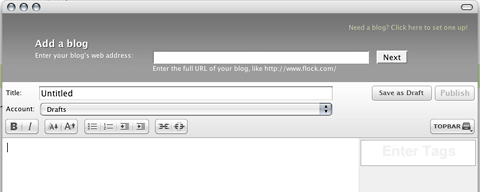As many
of you know, I've raved about Firefox in the past. Popup blocking,
RSS feeds, search from the toolbar - all things Safari has - plus
extensions (like AdBlock, which you can set to block those annoying
Flash ads) and themes (including one that makes Firefox look like
Safari).
That's Firefox, and now there's Flock.

The Flock Menu Bar
Flock is based on Firefox. When you open it, you'll notice the
familiar toolbar with search and the extensions and themes in the
Tools menu, but you'll also notice a few extras. Flock is supposed
to be an application for 'Web 2.0', the next-generation of the
Internet, bringing the idea that Internet users should be able to
modify it.

The Address Field
The first thing you'll notice about Flock is the star button
next to the address field. This is Flock's new approach to
bookmarks. You visit a page you like, and click on the star. It'll
then ask you if you want to sign up for a del.ico.us account.
Signing up for one allows you to share your bookmarks with other
users on the Internet - it's a great way to share potentially
interesting websites, and you only share the ones you want to.

Favorites Manager
The favorites manager is great as well - it allows you to view
your favorites as well as the RSS feeds for any that might have
them (for example, BBC News). You can also tag certain favorites
with phrases that might be helpful in finding them (short words
like 'cars', 'racing', or 'motorsports').
And, like Firefox, Flock has a history search, which I've found
indispensable. They claim that it's better than Firefox's
(apparently the pages in your history get indexed for better
searching), but I haven't found much of a difference.

Flock's Blog Editor
The most publicized feature is the built-in blog editor. It's
easily accessible from anywhere - just click the pen icon on the
toolbar. If you get a great idea while browsing some obscure site,
you no longer have to go back to your blog's editing page or open a
separate application to write something. It works with Movable
Type/LiveJournal among others.
If you use Flickr (I don't, but this feature might be enough to
convince me that I should), you can add your photos on Flickr right
into the blog post by dragging and dropping the image. No typing in
the complicated URL, no trying to copy and paste links - just drag
it right into the text box. Unfortunately it doesn't support
Webshots, which is a bit more popular than Flickr currently is.
Then there's the shelf. It's a great idea - it opens up as a
window where you can drag URL's, pictures, or clips of text that
you want to keep on hand to blog about later.
Flock is a great concept. However, I don't think it has
mass-appeal at the moment. It caters to a relatively small - but
steadily growing - population of Internet users who've gotten
involved in blogging and creating their own sites.
For those who's primary need for the Internet is checking email,
ordering books and CDs online, and maybe paying a bill or two, I
don't think Flock will offer much more to them than Firefox
does.
I plan to continue watching the development of this browser. It
combines two things I like - Firefox and blogging - in one package.
Unfortunately, it's only in its 'developer preview' stage, but
there's a pretty good possibility that I might use it as my main
browser once a final release version arrives. 





